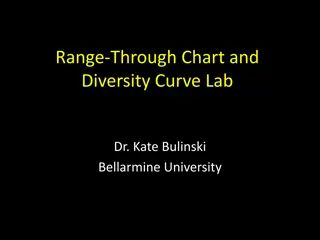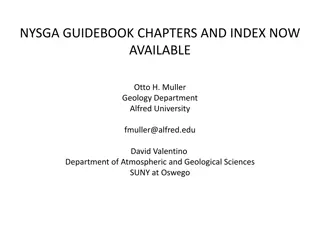Exploring Fossils: Extensive Reading for Grade 6
Discover the world of fossils with this Grade 6 English lesson on extensive reading. Students will learn about fossils, museums, bones, nests, scientists, clues, and footprints. The lesson includes pre-reading activities, matching exercises for new words, reading passages about fossils, and comprehe
1 views • 21 slides
Exploring the Fascinating World of Fossils
Dive into the realm of fossils with insights on different types such as body fossils, subfossils, microfossils, macrofossils, and unusual fossils. Discover how these remnants provide a glimpse into the past and help understand ancient life forms.
1 views • 14 slides
Evolution and Plant Systematics Lecture Overview
This lecture outline delves into the concepts of evolution, unity, and diversity of organisms on Earth, covering topics such as fossils, Lamarck and Darwin's theories, adaptation, natural selection, artificial selection, Carolus Linnaeus' systematics, plant evolution, and the demonstration of evolut
5 views • 26 slides
Insights into the Holocene Epoch: Climate, Fossils, and Human Migration
Explore the Holocene Epoch through case studies, fossil records, and climate models. Learn about the peak temperatures, environmental changes, and human migration patterns. Discover how past climate conditions are reconstructed using fossils and lake sediments, and delve into the various factors con
2 views • 25 slides
Understanding Fossil Diversity in Geology Labs
Explore the world of fossils and geological time scales in a Geology for Non-Science Majors lab under Dr. Kate Bulinski at Bellarmine University. Understand major paleontological events, diversifications, mass extinctions, and groups of organisms while learning to graph in Microsoft Excel.
0 views • 21 slides
Exploring Plate Motion and Fossils in Science Class
Dive into the fascinating world of plate motion and fossils in this science lesson. Students will learn about the role of scientists, investigate fossils as time capsules, meet a paleontologist, and explore how Dr. Wilson's research sheds light on Earth's geologic history. Engaging activities such a
0 views • 25 slides
The Origin of Viruses: Theories and Evidence
Viruses are acellular parasites with a complex replication mechanism. Studies on their origin present challenges due to the lack of fossils. Three main hypotheses include regressive, cellular origin, and co-evolution. The regressive hypothesis suggests viruses originated from complex ancestors that
2 views • 25 slides
Exploring Plant Fossils in Ethnobotanical Studies
Ethnobotany relies on various sources of data, including plant fossils. Fossils play a crucial role in identifying plants used by ancient societies, with specialized fields like paleobotany reconstructing past environments. Different types of plant fossils like coprolites, petrifactions, cast-on-inc
0 views • 21 slides
Understanding Resins: Composition, Occurrence, and Classification
Resins are solid/semisolid amorphous products with complex chemical composition and are found in plants, animals, and fossils. They contain essential oils, terpene products, and carboxylic acids. Resins occur as a result of normal metabolism or in response to injury, forming physiological or patholo
1 views • 37 slides
Understanding Rock Correlation Through Facies and Biostratigraphy
Explore the correlation of rocks using facies and biostratigraphy in Activity 3 of EOSC 326. Learn about constructing biozones, correlating stratigraphic logs, and interpreting paleoenvironments. Discover the significance of fossils B and F in correlation and apply techniques like seriation in const
5 views • 19 slides
Understanding Resins in Pharmacognosy: Properties and Occurrence
Resins are solid or semi-solid amorphous products rich in carbon atoms, found in plants, animals, and fossils. They contain essential oils, terpenes, and carboxylic acids. Resins have unique chemical and physical properties and are secreted in specialized structures like resin cells and glandular ha
0 views • 11 slides
Understanding Human Evolution: From Ancestral Lineage to Modern Hominids
Human evolution is a fascinating journey of change and development, where humans emerged as a distinct species. The theory of evolution highlights our common ancestry with other organisms, including chimpanzees. Evidence from fossils, genetics, and culture supports the idea of a shared ancestor amon
1 views • 23 slides
Exploring Evolution and History: Fossils, Inventors, and More
Delve into the fascinating world of evolution, history, and inventions with a diverse range of topics covered, from fossil findings to the innovative creations of inventors like Garrett Augustus Morgan. Discover intriguing details about ancient species, geological formations, and remarkable individu
1 views • 41 slides
Exploring Geological Insights: NYSGA Guidebook Chapters and Index
Discover the wealth of information available in the NYSGA Guidebook, with chapters on evolving thoughts in geology, field trip guidebook instructions, and fascinating insights into rocks and fossils. Explore the collaboration between Alfred University and SUNY at Oswego in advancing geoscience educa
0 views • 24 slides
The Theory of Continental Drift: Alfred Wegener and Pangaea
Alfred Wegener proposed the theory of continental drift, suggesting that the continents were once part of a single landmass called Pangaea. Evidence such as fossils and rock formations on different continents supports this theory. The concept of plate tectonics further explains the movement of conti
0 views • 6 slides
The Fascinating Theory of Continental Drift Explored
In the early 1900s, Alfred Wegener introduced the groundbreaking hypothesis of continental drift, suggesting that the continents were once part of a single landmass before drifting apart to their current locations. This theory is supported by evidence such as the alignment of continents, shared foss
0 views • 25 slides
Potential Sinking of Catalina Island Raises Concerns for Los Angeles
Santa Catalina Island may be sinking, posing a future risk of a tsunami to the mainland. Scientists are studying the island's tilt and potential landslides to determine its geological changes. The presence of ancient fossils could confirm whether Catalina is sinking or rising, with implications for
0 views • 5 slides
Syntactic Reconstruction from Linguistic Fossils in Uralic Languages
Linguistic fossils provide valuable insights for syntactic reconstruction in Uralic languages like Hungarian, Eastern Khanty, and Samoyedic. Through a case study, constraints on topical objects and grammatical systems are examined using linguistic fragments.
0 views • 34 slides
Exploring the Fascinating World of Dinosaurs
Delve into the world of dinosaurs - ancient reptiles that roamed the Earth millions of years ago. Discover the various types of dinosaurs, their unique characteristics, reproduction methods, diet preferences, and the mystery surrounding their extinction. Uncover the remnants of these creatures throu
0 views • 10 slides
Exploring Art and Design in Year 8 Curriculum
Delve into the Year 8 Art and Design curriculum, focusing on unique term topics such as viewing through windows, unexpected angles, and exploring fossils. Students will engage with creativity, critical understanding of artists, and benefit from gallery visits to enhance personal development and hist
0 views • 36 slides
Phylogenetic Signals in Phytosaur Tooth Enamel Microstructure
This study explores phylogenetic signals in phytosaur tooth enamel microstructure and their implications for Newark Supergroup phytosaurs. It discusses the traditional phylogenetic position, recent interpretations, key features, identification challenges, ideal fossils, localities, and the evolution
0 views • 27 slides
The Theory of Plate Tectonics: Continents in Motion
Earth's crust and lithosphere have changed over geologic time, forming tectonic plates that move due to convection currents. The concept of plate tectonics explains how continents fit together, the existence of a supercontinent called Pangaea, and natural phenomena like earthquakes and mountains. Ea
0 views • 28 slides
Engaging High School Students with Taphonomy: Dead and Fossilized
Explore a gamified curriculum unit, "Taphonomy: Dead and Fossilized", designed to immerse high school students in Earth sciences through interactive gameplay, assessment tools, and rich learning objectives aligned with NGSS and TEKS standards. Discover a self-contained module focusing on fossils, ev
0 views • 15 slides
Exploring Human Origins Through Hominid Fossils and Evolutionary Traits
Delve into the fascinating world of human origins, examining hominid fossils, anatomical traits, and evolutionary evidence. Learn about early species like Ardipithecus ramidus, differentiate African apes from modern humans, and analyze the genetic lineage supporting human evolution. Explore tables,
0 views • 14 slides
Understanding Human Evolution: Evidence of Common Ancestors
Explore evidence supporting the common ancestors for living hominids, including humans. Delve into phylogenetic trees, shared characteristics with African apes, and anatomical differences. Learn about the Hominidae family, genus Homo, and the terms "hominid" and "hominin.
0 views • 93 slides
Unraveling the Geologic Mysteries of Earth's History through Dating Methods
Delve into the fascinating world of Earth's history and dating techniques with images and puzzles exploring concepts like relative dating using the Law of Superposition, geological layer sequencing, and absolute dating through half-life principles. Learn how scientists decipher the age of the Earth
0 views • 10 slides
Understanding Evolutionary Evidence in Biology
Fossil records, comparative embryology, anatomy, convergent and divergent evolution, cell biology, and serology provide compelling evidence for common ancestry and evolutionary relationships among organisms. Fossils offer a glimpse into the past, while comparative studies highlight similarities in s
0 views • 7 slides
Exploring Paleoecology: Interactions Across Geologic Time
Paleoecology studies the interactions between life and non-living factors in environments over millions of years. Scientists reconstruct ancient environments using paleontology, sedimentology, and chemistry. Foraminifera, single-celled organisms with calcium carbonate shells, are valuable index foss
0 views • 7 slides
Unveiling Earth's Past: Fossils and Geological Clues
Explore the mysteries of Earth's past through fossils, rocks, and geological evidence. Learn how paleontologists decipher ancient life and environments, from unique preservation methods to the principles of catastrophism and uniformitarianism. Delve into the formation of fossils and the slow process
0 views • 25 slides
Understanding Microfacies Analysis in Sedimentary Geology
This chapter discusses field work studies, sampling strategies, and laboratory methods essential for microfacies analysis. It emphasizes the importance of precise field records, vertical and lateral variations in sampling, and studying microscopic features along with mineralogical and geochemical da
0 views • 22 slides
Exploration of Fossils and Compounds in Science Learning
Archaeologists search for fossils in specific types of rocks, while students learn about compounds and their formation through engaging activities. Compounds are combinations of two or more elements, each with distinct naming conventions. Students practice naming compounds based on their constituent
0 views • 10 slides
Understanding Fossils and Fossil Fuels
Explore the world of fossils and fossil fuels, learning how they are formed and what they reveal about Earth's history. Discover the various types of fossils, from imprints to whole organisms preserved in amber. Uncover the importance of fossils in studying geological changes over time and understan
0 views • 15 slides
Understanding Fossils: Formation, Types, and Significance
Explore the world of fossils and learn about their formation process, different types such as mold, cast, and petrified fossils, and the valuable insights they provide to scientists. Discover how fossils capture the remains of ancient plants and animals, revealing clues about the past through their
0 views • 25 slides
Decoding Cloning Extinct Animals: Pros, Cons, and Methods
Delve into the fascinating world of cloning extinct animals presented by Jacob Engen and Joe Bertolini. Explore the reasons for and against reviving these creatures, alongside the challenges and methods involved in the cloning process, including the ethical implications and potential environmental i
0 views • 5 slides
Development of Museum Department at Calvin College - A Vision Realized
Calvin College's Museum Department of Geology, Geography, and Environmental Studies, led by individuals like Bruce Dice and scholarship recipients, has come to life through the dedication of key figures like Bob Berkhof and Phil Beezhold. The museum showcases a range of exhibits, including rare mine
0 views • 20 slides
Exploring Vertebrates: Skeletons and X-rays
Dive into the world of vertebrates with a detailed exploration of their skeletons and X-rays. Discover the fascinating structures of frogs, snakes, lizards, birds, fish, humans, bats, dogs, dolphins, and even dinosaur fossils. Explore the intricate details through a series of captivating images, she
0 views • 18 slides
Exploring Earth's Geologic Time and Extinction Events
Geologic Time reveals the Earth's 4.54 billion-year history through fossils, rocks, and ice cores. The Geologic Timescale provides insights into the planet's past, showcasing diverse life forms and major evolutionary events. Extinction events, both gradual and rapid, shape eras in Earth's timeline,
0 views • 22 slides




































